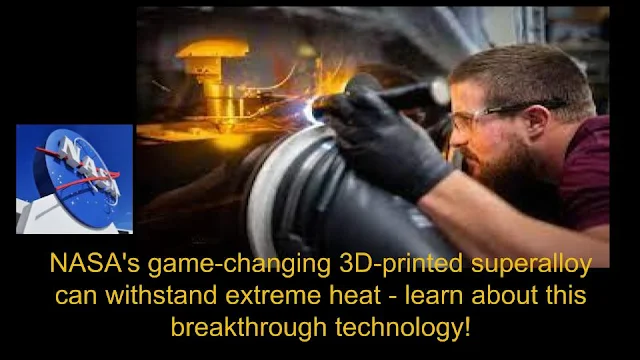NASA's game-changing 3D-printed superalloy can withstand extreme heat - learn about this breakthrough technology!
NASA's game-changing 3D-printed superalloy can withstand extreme heat - learn more about this breakthrough technology!
#NASA #3Dprinting #superalloys #technology #innovation #sustainability
NASA has recently developed a new 3D-printed superalloy that can withstand extreme temperatures. This groundbreaking innovation could have major implications for the aerospace industry and beyond.
Superalloys are a group of metals that have been specially designed to withstand high temperatures and extreme pressure. They are commonly used in engines, turbines, and other machinery that needs to operate under intense conditions. However, traditional methods of manufacturing superalloys have been limited by their structural properties, making them susceptible to warping and cracking.
To overcome these limitations, NASA has developed a new technique that combines 3D printing with superalloy production. This method uses lasers to fuse layers of superalloy powder into a solid object, creating a material with superior strength and durability.
The benefits of this new technique are manifold. Not only can it produce superalloys that are stronger and more heat-resistant than traditional methods, but it also allows for greater customization and precision in manufacturing. This means that parts can be designed and produced to exact specifications, reducing waste and increasing efficiency.
The potential applications of this technology are numerous. In the aerospace industry, it could be used to produce lighter and more fuel-efficient engines, while also reducing maintenance and repair costs. It could also be used in other high-temperature industries, such as energy production and manufacturing.
One of the most exciting aspects of this new technology is its potential for sustainability. By reducing waste and increasing efficiency, 3D printing could have a significant impact on the environmental footprint of the manufacturing industry. This could lead to a more sustainable and eco-friendly future for industries that rely on high-temperature materials.
In conclusion, NASA's new 3D-printed superalloy is a major breakthrough in the field of materials science. Its ability to withstand extreme temperatures and pressures, while also allowing for greater customization and precision, makes it a game-changer for industries that rely on high-temperature materials. With its potential for increased sustainability, this technology could have a transformative impact on the manufacturing industry and beyond.
 |
| NASA's game-changing 3D-printed superalloy can withstand extreme heat - learn about this breakthrough technology! |
NASA has recently developed a new 3D-printed superalloy that can withstand extreme temperatures. This groundbreaking innovation could have major implications for the aerospace industry and beyond.
Superalloys are a group of metals that have been specially designed to withstand high temperatures and extreme pressure. They are commonly used in engines, turbines, and other machinery that needs to operate under intense conditions. However, traditional methods of manufacturing superalloys have been limited by their structural properties, making them susceptible to warping and cracking.
To overcome these limitations, NASA has developed a new technique that combines 3D printing with superalloy production. This method uses lasers to fuse layers of superalloy powder into a solid object, creating a material with superior strength and durability.
The benefits of this new technique are manifold. Not only can it produce superalloys that are stronger and more heat-resistant than traditional methods, but it also allows for greater customization and precision in manufacturing. This means that parts can be designed and produced to exact specifications, reducing waste and increasing efficiency.
The potential applications of this technology are numerous. In the aerospace industry, it could be used to produce lighter and more fuel-efficient engines, while also reducing maintenance and repair costs. It could also be used in other high-temperature industries, such as energy production and manufacturing.
One of the most exciting aspects of this new technology is its potential for sustainability. By reducing waste and increasing efficiency, 3D printing could have a significant impact on the environmental footprint of the manufacturing industry. This could lead to a more sustainable and eco-friendly future for industries that rely on high-temperature materials.
In conclusion, NASA's new 3D-printed superalloy is a major breakthrough in the field of materials science. Its ability to withstand extreme temperatures and pressures, while also allowing for greater customization and precision, makes it a game-changer for industries that rely on high-temperature materials. With its potential for increased sustainability, this technology could have a transformative impact on the manufacturing industry and beyond.
Also read:
Appy Pie Adds Artificial Intelligence to Its No-Code Website Builder Platform.jpg)


Comments
Post a Comment